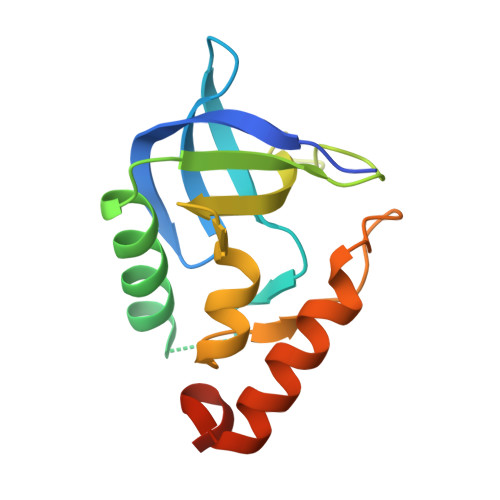Electrostatic effects in a network of polar and ionizable groups in staphylococcal nuclease.
Baran, K.L., Chimenti, M.S., Schlessman, J.L., Fitch, C.A., Herbst, K.J., Garcia-Moreno, B.E.(2008) J Mol Biology 379: 1045-1062
- PubMed: 18499123
- DOI: https://doi.org/10.1016/j.jmb.2008.04.021
- Primary Citation of Related Structures:
2QDB, 2RDF - PubMed Abstract:
His121 and His124 are embedded in a network of polar and ionizable groups on the surface of staphylococcal nuclease. To examine how membership in a network affects the electrostatic properties of ionizable groups, the tautomeric state and the pK(a) values of these histidines were measured with NMR spectroscopy in the wild-type nuclease and in 13 variants designed to disrupt the network. In the background protein, His121 and His124 titrate with pK(a) values of 5.2 and 5.6, respectively. In the variants, where the network was disrupted, the pK(a) values range from 4.03 to 6.46 for His121, and 5.04 to 5.99 for His124. The largest decrease in a pK(a) was observed when the favorable Coulomb interaction between His121 and Glu75 was eliminated; the largest increase was observed when Tyr91 or Tyr93 was substituted with Ala or Phe. In all variants, the dominant tautomeric state at neutral pH was the N(epsilon2) state. At one level the network behaves as a rigid unit that does not readily reorganize when disrupted: crystal structures of the E75A or E75Q variants show that even when the pivotal Glu75 is removed, the overall configuration of the network was unaffected. On the other hand, a few key hydrogen bonds appear to govern the conformation of the network, and when these bonds are disrupted the network reorganizes. Coulomb interactions within the network report an effective dielectric constant of 20, whereas a dielectric constant of 80 is more consistent with the magnitude of medium to long-range Coulomb interactions in this protein. The data demonstrate that when structures are treated as static, rigid bodies, structure-based pK(a) calculations with continuum electrostatics method are not useful to treat ionizable groups in cases where pK(a) values are governed by short-range polar and Coulomb interactions.
- Department of Biophysics, The Johns Hopkins University, 3400 N. Charles St., Baltimore, MD 21218, USA.
Organizational Affiliation:

















